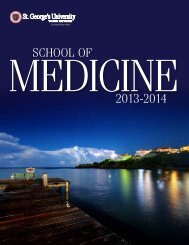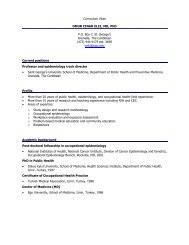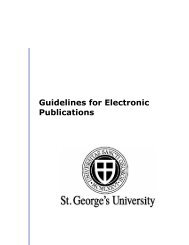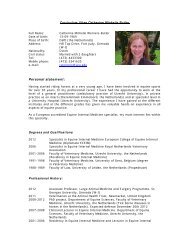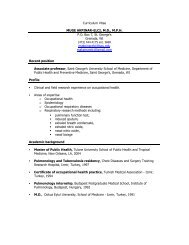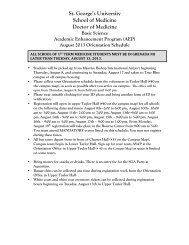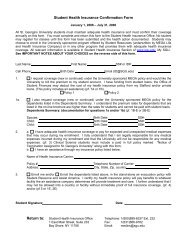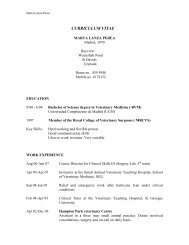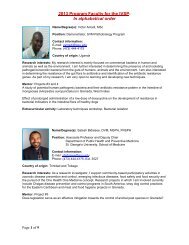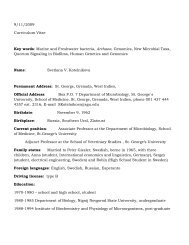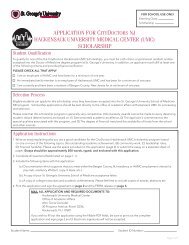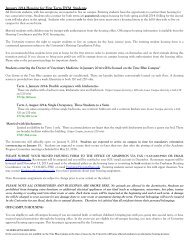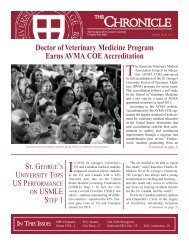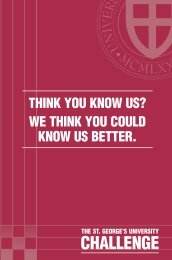SVM Catalogue 2012-2013 - St. George's University
SVM Catalogue 2012-2013 - St. George's University
SVM Catalogue 2012-2013 - St. George's University
Create successful ePaper yourself
Turn your PDF publications into a flip-book with our unique Google optimized e-Paper software.
School of Medicine<br />
Course Descriptions<br />
PTHB 516<br />
Avian, Fish, and Exotic Animal Diseases<br />
(4 cr.) (Didactic 3 cr./Laboratory 1 cr.) This course focuses<br />
on the etiology, pathogenesis, diagnosis, and treatment of<br />
the important diseases in domestic poultry, pet avian, and<br />
exotic animal species that are commonly encountered as<br />
pets and used for laboratory purposes (including reptiles,<br />
amphibians, rabbits, small rodents, ferrets, etc.). <strong>St</strong>rategies<br />
for species management, handling and disease prevention<br />
are emphasized. The course deals with various aspects<br />
of aquaculture, including food fish, shellfish, pet fish, and<br />
public display aquaria.<br />
SAMS 514<br />
Introduction to Surgical Skills<br />
(1 cr.) (Didactic 0.33 cr./Laboratory 0.67 cr.) The course is an<br />
introductory surgical course designed to introduce basic<br />
surgical principles and skills that will serve to prepare the<br />
student for veterinary surgery. Didactic and laboratory<br />
discussions include basic surgical principles: asepsis,<br />
sterilization, and disinfection; surgical instrumentation and<br />
surgical techniques; surgeon and patient preparation; suture<br />
materials and surgical needles; and hemostasis, wound<br />
healing and wound management. Surgical skills mastered<br />
during the laboratory sessions include knot tying, suture<br />
patterns (skin, hollow organ, and tendon), ligatures, surgical<br />
drape application, and bandaging. <strong>St</strong>udents are provided<br />
opportunities to practice surgical skills using both live tissue,<br />
simulation models (i.e., skin and intestine), and suture boards.<br />
SAMS 520<br />
Veterinary Anesthesiology<br />
(3 cr.) (Didactic 2.5 cr./Laboratory 0.5 cr.) In the didactic<br />
portion of this course, students gain an understanding<br />
of the principles, concepts, and techniques utilized in<br />
general and local anesthesia in various small and large<br />
animal species, as well as the basic terminology and proper<br />
use of anesthetic equipment and monitoring devices.<br />
Laboratory sessions provide the opportunity to master<br />
equipment use (anesthetic machines and monitoring<br />
devices) necessary for providing safe anesthesia. The SGU<br />
Simulation Laboratory is used to practice and gain comfort<br />
with endotracheal intubation and video demonstrations<br />
of veterinary anesthesia-related procedures are used<br />
to familiarize the student with additional concepts in<br />
anesthesia. This course is designed to prepare the student<br />
to enter the Junior Surgery and Anesthesia Laboratory<br />
course (SAMS 527) in Term 5.<br />
Year 2: Terms 3 and 4 Elective Courses<br />
All Year 1: Terms 1 and 2 elective courses listed above are<br />
available to Year 2: Terms 3 and 4 students. In addition, the<br />
following elective courses are available to Term 4 students:<br />
Year 2: Term 4 Elective Courses<br />
eLeC 509<br />
Diseases of North American Wildlife I<br />
(1 cr.) (Didactic) This course focuses on common North<br />
American wildlife species from the viewpoint of a<br />
veterinarian involved in their management. The impact of<br />
transmission of wildlife diseases on human and domestic<br />
animal health are addressed and interactions between<br />
52 | <strong>St</strong>. George’s <strong>University</strong>



